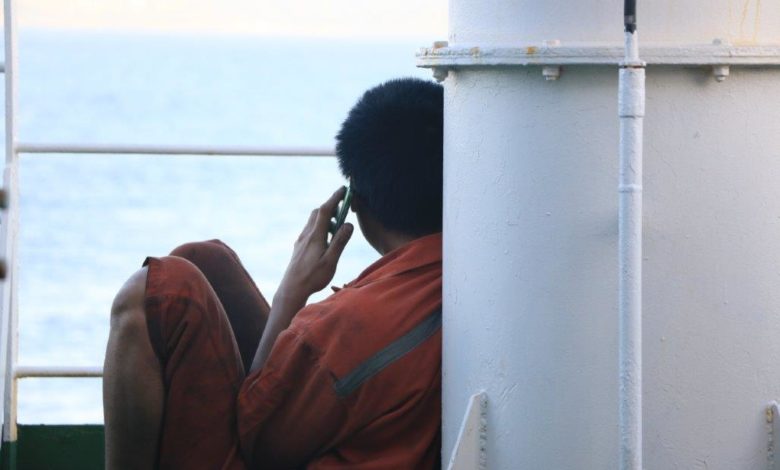Richard Turner, CEO of Tapiit Live, on the challenges we face to ensure happiness at sea
Having been overlooked and considered taboo for many years, the issue of mental health is steadily emerging. Major public figures such as the Duke and Duchess of Cambridge in the UK have engaged in campaigns to promote mental wellbeing, an effort that has been supported by government and non-governmental authorities around the world. Real strides have definitely been made, but there are still areas where the shadows remain, and progress is far from universal.
Unfortunately, one such example is the maritime industry. Despite the burden of long stretches at sea, and the obvious impact this has on a seafarer’s mental wellbeing, the issue of mental health has not been a particular focus. And with continuing Covid-19 restrictions, the issue is more pressing than ever before.
An unseen crisis
The dangers of Covid have led countries to prevent vessels from docking, leaving huge numbers of men and women stranded on the waters.
The Neptune Declaration – signed by over 600 companies, including Shell, BP, Unilever and Rio Tinto – outlines some of the actions needed to tackle the crew change crisis, and also makes reference to the physical and mental implications of long stretches at sea. This point is echoed by the Maritime Industry of Jamaica (MAJ), which has warned that the crisis risks creating a shortage of seafarers if exhausted crew decide to leave the industry rather than face another long period trapped at sea.
Long-term issues
Clearly, there is an immediate crisis happening on our waters, but poor mental health among seafarers is an issue that pre-dates the pandemic. The full extent of the problem is hard to quantify, partially because of a lack of research, but also as a dearth of population figures makes it difficult to construct fatality or suicide rates. However, the 2019 study by Helen Sampson and Neil Ellis found the modest availability of evidence to indicate higher levels of psychiatric disorders among seafarers compared to other occupations, with 37% in 2016 having experienced a recent-onset deterioration of mental health. They also pointed to the evidence that some ranks of seafarers are more likely to experience emotional exhaustion and ‘burnout’ than others.
Despite the difficulty of accurately populating suicide rates, the few studies that have attempted this present us with worrying results. Robert T.B. Iversen compared the 2011 UK suicide rate of 1.2% of all deaths to Roberts et al.’s findings of a 3.8% figure among a UK fleet 1986-2009 and Borsch et al.’s 11% on a Danish fleet 1986-2011 to argue it to be ‘incontrovertible’ that suicide among seafarers is a serious concern.
The evidence is clearly problematic, but an understanding of life at sea perhaps provides a more emotional case. Maritime crews spend months at a time away from family and friends; live in cramped conditions alongside strangers; and often experience sleep deprivation due to long hours and loud noises. This, combined with the job insecurity that comes with contracted work, makes it wholly unsurprising that the above findings suggest loneliness, anxiety and depression be more prevalent than in the rest of society.
Room for improvement: traditional solutions to contemporary problems
Strides have been made within our industry, and it certainly hasn’t remained sheltered from the sea change in public consciousness towards mental health. Training on the issue is steadily being normalised on vessels around the world, with e-learning the dominant method since it can be conducted while vessels are still at sea. But it is worth exploring the ways that this training could be improved in order to support the 400,000 seafarers who are currently stranded, as well as the millions of others who venture out every year.
To start, the focus of mental health training is understandably reactive, centred on things like how to spot the signs of anxiety and depression, and how to respond. But whilst this is hugely important, it neglects the stage beforehand in which people are struggling without entering into a crisis. By providing coping mechanisms, teaching mindfulness and encouraging open conversation, the current disconnect between mitigative and preventative measures can be avoided, as people are left with a far broader arsenal for tackling problems as they arise.
The question of who courses are delivered to must also be considered. Currently, training is given to the crew and mostly bypasses management. But in an industry dominated by men and made up largely by contract workers who perhaps fear losing their jobs if they reveal their mental issues, broader cultural shifts are required. Thus, a top-down change is necessary, in which ships’ senior management are taught to consider their own mental health and how they can communicate more openly, and from there a shifting discourse can filter down to allow crewmates to talk openly about the way they feel and avoid falling into a crisis.
The role of technology
New technologies are also allowing the delivery of mental health training to reach new bounds. The solution, up to this point, has been e-learning – videos and tasks are sent to the crewmates to undertake as and when they please. But now modules can now be live-streamed to vessels around the world, allowing interactive sessions that mirror face-to-face teaching without forcing ships to come into harbour. Where colleagues are interacting less and less because technology is, ironically, keeping them so disconnected from the world around them, this live stream training is not just a chance to bring crewmates together, but also to encourage the sort of open and honest conversation that can drive broader cultural shifts.
Perhaps, therefore, the solution is right in front of our very eyes, in the screens, systems and satellites that power this modern world and bridge the gaps between oceans and continents at the click of a button.
[Source: splash247.com – May 18, 2021]







